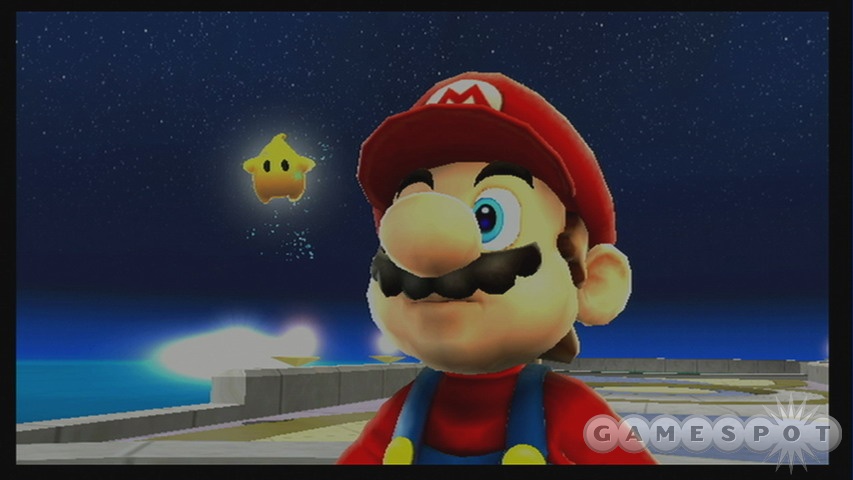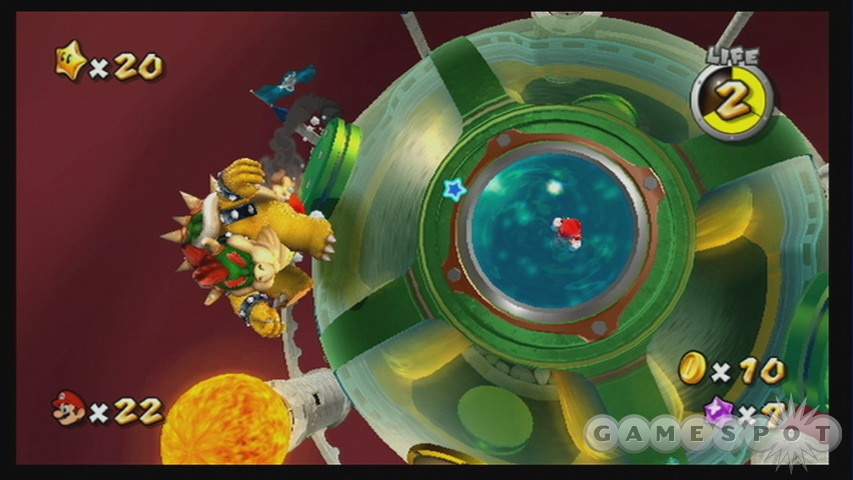Here is the game that Wii owners have been pining for, a game that has tons of appeal for both the less experienced player and the longtime gamer. A game that deftly combines accessibility and challenge, all wrapped up in a package that's both deep and addictive. Super Mario Galaxy is all of this and more. It is simultaneously one of Mario's best adventures and a game that doesn't require fandom of the portly plumber's previous engagements to appreciate. The sheer quality of Mario Galaxy's wonderful level designs, tight controls, and brilliant presentation is the sort of thing that just about anyone who loves gaming should be able to appreciate, and that many will fall head-over-heels for.

The premise for Mario Galaxy begins in fairly well-worn territory. Mario receives a note from his beloved Peach to come to the castle, for she has a special "gift" for him. He arrives, only to walk straight into chaos as Bowser and son arrive in a fleet of airships and use a giant UFO to pluck the Princess' castle right out of the ground. Mario gives chase, but is unable to rescue her before the fearsome twosome jet off into space. This all certainly sounds par for the course, but it's where Mario ends up that gives Mario Galaxy its own flavor. Mario eventually hooks up with a creature called a luma, from a race that looks like some kind of cross between an invincibility star and a headless chicken. The lumas are led by an enigmatic woman named Rosalina, who lives with them on a crazy spaceship called the comet observatory. Mario learns that Bowser has made off with a gaggle of power stars used to power the observatory. To reach Bowser's hideout, Mario has to travel to all the various galaxies in the universe to collect as many power stars as he can in order to power the ship back up, fly to the center of the universe, rescue the princess, and set everything right again.
Mario 64, anyone? If you played that seminal game, Mario Galaxy's star hunt progression probably sounds familiar to you. But apart from that basic structuring, you can hardly call Mario Galaxy a Mario 64 rehash. If anything, Mario Galaxy simply takes the basics of what made Mario 64 such a dynamite game, and turns them completely crazy.
The definition of crazy here has a lot to do with gravity and physics. Each galaxy contains a series of little worlds that can't even really be called planets so much as they are floating puzzles. In many of these worlds, Mario can walk just about anywhere. When he lands on a sphere, he can walk all over it, going sideways and upside down in the process. Sometimes you'll simply jump in one area and end up gravitating toward the ceiling or walls or even another nearby planetoid without even realizing it. Often Mario will need to track down launch stars, which, when you shake the Wii Remote while standing near or inside one, will send you flying to a whole new, previously inaccessible area. There are even sections where you'll be floating through space, using specialized pull stars to hop from area to area, all while floating through the spatial void.
Practically every galaxy you explore is an absolute joy to experience. The level designs here are top flight in every regard, with tons of clever and sometimes dastardly traps and puzzles for Mario to navigate. The difficulty doesn't start off terribly high, but as time goes on, the game ramps up nicely, building the challenge steadily until the final areas, which, though perhaps a bit frustrating to inexperienced players, provides the exact sort of tough workout you've come to expect from a Mario adventure. But even aside from the challenge level, simply exploring all these various galaxies is half the fun. Whether you're floating from land mass to land mass on a giant spinning flower, running frantically around a giant series of platforms that shrink to nothing the first time you touch them, or taking on one of several terrific 2D side-scrolling areas reminiscent of New Super Mario Bros. for the DS, you won't be wanting for variety while playing through Galaxy's dozens of levels.
In a sort of nod to the suit-happy gameplay of Super Mario Bros. 3, Mario can don a number of different costumes that give him new abilities. For instance, in several levels, Mario can take on the abilities of a bee, buzzing around through the air via his new pair of wings, and wall-climbing specific honeycombed areas of the environment. With others, Mario can freeze water to walk over it, launch fireballs (natch), fly, wrap himself in a Mario-sized spring and jump to great heights, turn invincible (natch, again) and even turn into one of those pesky boos, allowing him to float around and pass through some solid walls. In most cases, the game takes great advantage of these abilities in the context of each level. A few involving the bee suit are a bit frustrating (given that you lose the suit when you touch water) and the spring suit is kind of a pain to control given Mario's perpetual bounciness, but otherwise, these abilities add a great dimension to the already excellent gameplay.

Apart from the screwiness of the spring suit, there's very little issue to be taken with Mario Galaxy's controls. At its core, it controls much as Mario 64 did, but with a couple of Wii-centric twists. For one, Mario's primary attack is a basic spin move (the same spin move you use to activate launch stars). Simply shaking the Wii Remote engages the spin, and it's an extremely responsive mechanic. The one trick to it is that you have to wait a second before spinning again, so you want to make sure you're able to get away from whatever bad guy is nearby if you happen to miss.
The other key change is the addition of the Wii Remote as a pointer. Simply by pointing at them on the screen you'll collect star bits, which can be found just about everywhere and serve as both Super Mario Galaxy's currency and as a weapon. Firing star bits is as simple as aiming the Wii Remote at an enemy and pressing B to launch. But you don't want to fire off too many of those, as they come in handy for unlocking new stages later on. Only in a few specific cases does the game really dabble in true motion control, such as sections where you're surfing on a manta ray or walking on a boulder. But even these few divergences from the standard gameplay formula are largely successful and quite fun.
Mario Galaxy's journey is scattered and epic all at once. There isn't much of a thread tying together all these disparate worlds, apart from the fact that they have power stars hidden within them somewhere. And yet, at the same time, the lack of cohesion in what you're doing never really gets in the way of your enjoyment of it. Because each level is so much an island unto itself, it actually makes each one stand out all the more.
It helps that practically every stage in the game has a great deal of replayability purely on its own merits. These levels are just inherently fun to go back to again and again, and that the game gives you plenty of reason to is even better. Once you complete an area, you can go back and engage in a specialized version of it in certain cases. Essentially, comets will enter orbit in some of these galaxies, and thus change the way you play in some bizarre way. Whether it's speeding up all the enemies in an area, putting you on a timed run, or having you race against a doppelganger Mario, there's a nice variety of change-ups to experience. The adventure probably won't take you more than 12 to 15 hours if you just collect the minimum number of stars necessary to get to the end level, but you can certainly tack on a great deal more to that if you're into going back and collecting all the stars. And if you want to unlock the game's neat end surprise, you'll need to get all of them.
There is even a multiplayer component to the game, albeit a limited one. Another player can point their Wii Remote at the screen and take part in some of the basic fun, like collecting star bits, shooting star bits, and the like. You can even directly assist Mario by pointing at him and pressing A at the same time as your friend to make him do a super jump, and stop certain enemies from attacking by highlighting them with the pointer. It's not the most involved co-op mode you'll ever experience, but it can be fun if you've got someone enthusiastic alongside you.
As wonderful as Mario Galaxy's gameplay is, its graphics are even better. There simply isn't a better-looking Wii game available. A great deal of credit is due to the art design, which is simply phenomenal. The character designs, level details, animations, all of it is incredibly colorful and vibrant, and just a joy to look at. The technical engine does its part as well, keeping the frame rate drops to minor, infrequent bouts. One area especially worth noting is the game's camera, which takes a largely cinematic perspective, albeit with a limited amount of player control. You can adjust it right or left in certain areas, and go to a first-person view if you just want to look around. There are a few areas where the camera prevents you from seeing things perfectly, but mostly it does an excellent job of framing the action, especially considering all the kooky perspective shifting the game does as you run around these oddball environments. The only thing that's kind of a bummer is that you'll undoubtedly wish at some point while playing that the Wii could support resolutions higher than 480p; but even with the limited resolution, the game just looks beautiful.

Audio is also excellent, thanks largely to the top-notch soundtrack. Much of the music is made up of classic Mario tunes from a wide variety of different games, and it's all modernized and orchestrated. These are some of the best renditions of these tracks since the originals, and you're sure to be humming along as you play. There's little voice work in the game, but the few voice samples that are there are used to nice effect. It's probably better to just hear Bowser snarling than it is to hear him being a chatty Cathy, anyway. The sound effects are a touch on the shrill side at times, but the bulk of them fit the vibe of each stage nicely.
When all is said and done, the thing that really makes Super Mario Galaxy such a standout game isn't the fact that it's another Mario game, but the fact that it doesn't even need to be a Mario game to be successful. Sure, it's got all the nostalgic flavor Mario fans would want, with the updated soundtrack, familiar foes, and various other Mario-related bric-a-brac scattered throughout the adventure, but the game never leans on these nostalgic aspects as a crutch. It instead puts the whole of its focus on its gameplay design, and with good reason. You could probably swap in just about any other characters from practically any other franchise, and this would still be a phenomenally fun game. That it layers all these memorable characters and components on top of that phenomenal design just makes it all the sweeter. If ever there were a must-own Wii game, Super Mario Galaxy is it.